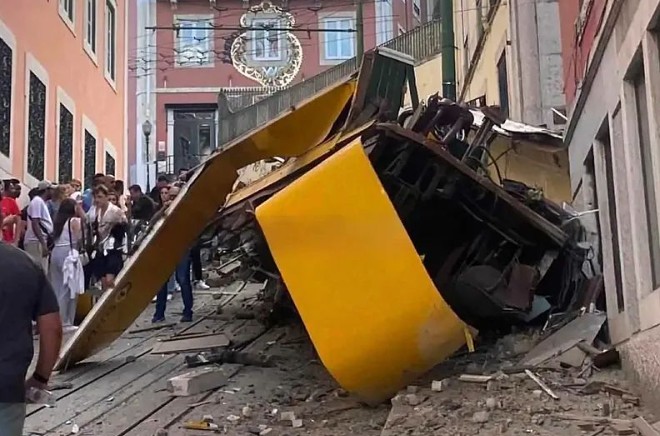Lisbon Funicular Crash Death Toll Rises to 17
The death toll from the devastating Gloria funicular crash in Lisbon has now climbed to 17, as authorities continue to grapple with one of the worst transport accidents in recent Portuguese history.
Among those killed was the brakeman, André Marques, who had been operating the railway cart’s ascent and descent moments before it overturned and collided with a building.
Sitra, the Transport Workers’ Union, confirmed his death, stating: “We extend our condolences to the families and friends of the victims of the accident and wish them a speedy recovery as well as the best recovery to the others injured in the accident.”
17 people were killed and 21 injured in a crash of a hillside funicular railway popular with tourists.
#Lisbon #Portugal #cableCar https://t.co/4CINqxc6MI— M̳a̳nks✮ (@shivrambhaj) September 4, 2025
Tragically, two further victims succumbed to their injuries in the sanitarium overnight, while the number of injured has risen to 21, with five people in serious condition.
Among them is a three- time-old child and his pregnant mama, who’s reportedly fighting for her life. The child’s father still didn’t survive.
The incident occurred around 6 pm on Wednesday when a string along the major road route came loose.
The Elevador da Glória, with its distinctive unheroic- and-white buses, is one of Lisbon’s most cherished sightseeing lodestones.
Video footage from the scene shows a pall of dust rising from the wreckage, with people rushing towards the chaos in hopeless attempts to help. Substantiations reported harrowing scenes.
“There are kids under the tram,” shouted one bystander as cries for help echoed through the streets. Another woman yelled: “It just f*****g smashed,” pointing at the mangled tram against the building.
The railway cart struck a hotel, leaving victims unconscious from the impact. A witness described: “The police took less than five minutes to arrive and told us to get back and the first ambulances started arriving five minutes later.
One of the victims I saw was cut all over the place and covered in blood. A lot of people appeared to be unconscious.”
Teresa d’Avó, speaking to Portuguese TV channel SIC, described the tram’s descent as catastrophic: “It hit the building with brutal force and fell apart like a cardboard box.” She added that the vehicle seemed to have no braking control.
Exigency services worked into the night to deliver those trapped in the wreckage, and authorities latterly verified that everyone had been freed.
Portuguese officers haven’t yet released the identities or ethnicities of the departed, but no British citizens are among them.
Victims reportedly include trippers from Germany, Spain, Canada, France, Cabo Verde, Italy, Switzerland, Morocco, and South Korea.
Why Did the Funicular Overturn?
Dating back to 1885, the Elevador da Glória is a heritage system with two buses, each rated for 43 passengers, travelling roughly 265 metres. Lisbon Firefighters reported that the crash was caused by a string that had come loose.
Professor Dave Cooper, chair of the UK Standards Committee for Cableways, told Metro: “From an engineering design perspective what we know is that the system opened in 1885 and is therefore unlikely to have complied with modern standards expected of a new cableway system. It can be described as a heritage system.
It had two cars, each rated at 43 persons and travelled a distance of some 265 metres.”
Prof Cooper also questioned why the emergency brake did not activate, explaining: “From description seen it is understood that the system had just set off with the lower car ascending and inversely the upper car descending.
Passengers from the lower car describe it that the car had just left the bottom station and travelled a short distance and then suddenly reversed and relaxed to its stopping position.
Given that the bottom car is still intact in that position and the top car that was descending is now down the track and has derailed it can be said that the relationship between the two cars has been lost.
The ropes that connected the two may have broken. It is understood that there were bends in the track and that if the top car was descending uncontrollably, the geometry of the track may have allowed the car to derail, given the speed that it would have achieved.
What is not understood is why the emergency brake (if there was one) on the uncontrollably descending car did not apply.
It is perhaps that it did, but was unfit to overcome a combination of the mass of the auto and its passengers and the speed at which it was travelling. ”
Examinations are ongoing, as officers work to determine exactly what went wrong and how such a major transport icon could be the point of such a woeful accident.






